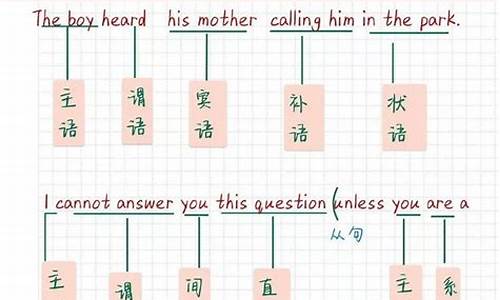句子的英文怎么说怎么写单词_句子的英语怎么写?
1.几个英文单词和句子
2.英语各种语法的英文名称,例如名词性从句怎么说?

此处的Word究竟是指单词还是句子的英文翻译?
此处的Word究竟是指单词还是句子
Whether the Word here is a word or a sentence?
重点词汇
此处here;?this place
究竟exactly;?actually;?ever;?outcome;?what actually hened
单词word;?individual word;?single-morpheme word
句子sentence
几个英文单词和句子
你知道句子的英文单词怎么写吗?一起来学习一下吧!
句子的英文单词: sentence
词组习语:
under sentence of
1. 被判刑
他被判处。
he was under sentence of death.
句子的英文单词例句:
1. These rules tell us how a sentence is broken down into phrases.
这些规则告诉我们一个句子是怎样分解成若干短语的。
2. Put a word in each blank to complete the sentence.
每个空格填上一个单词,把句子补充完整。
3. Your task is to interchange words so that the sentence makes sense.
你们要做的就是调换单词的位置以使句子意义通顺。
4. We he learnt how to condense serious messages into short, self-contained sentences.
我们已经学会了如何把重要的信息压缩成简短独立的句子。
5. A good way to sound confident is to use short punchy sentences.
想要听起来很自信,使用简短有力的句子不失为一个好方法。
6. a sentence with a determinate meaning
具有确定意义的句子
7. That sentence is not grammatical.
那个句子不合语法。
8. What does this sentence mean?
这个句子是什么意思?
9. Use a period at the end of the sentence.
在一个句子的末尾用句号.
10. If you change the words over, the sentence sounds better.
如果你把词调换一下位置, 这个句子听起来就更好了.
11. If you switch the words over, the sentence sounds better.
如果你把这几个词调换一下位置, 这句子听起来就好多了.
12. Look, you've typed " do " as'so " , and made nonsense of the whole sentence.
瞧, 你把do打成了so, 这样一来句子就不通了.
13. I he keyed this sentence three times, and it's still wrong!
我把这个句子输入了三次, 可是仍然不对.
14. This sentence does not seem to connect with the context.
这个句子似乎与上下文脱节.
15. A period is the regular ending for a sentence.
句点是一个句子符合规则的结尾.
英语各种语法的英文名称,例如名词性从句怎么说?
1.drilling
演练, 钻孔
2.environmental claims
环境申明
3.hodge-podge
大杂烩
4.Consumers are being confused and misled by hodge-podge of environmental claims made by household products according to a "green labeling"study published by Consumers International Fridy.
国际消费者周末日---它试图用那些普通产品上的杂乱的关于环境申明的"环保(绿色)标签"来掩盖(真相), 迷惑并误导客户
5.The 10-country study surveyed product packing in britain.
十国研讨组视察了英国的产品包装.
1、句式
从句clause
从属句 subordinate clause
并列句 coordinate clause
名词从句 nominal clause
定语从句 attributive clause
状语从句adverbial clause
宾语从句 object clause
主语从句 subject lause
同位语从句ositive clause
时间状语从句 adverbial clause of time
地点状语从句 adverbial clause of place
方式状语从句 adverbial clause of manner
让步状语从句 adverbial clause of concession
原因状语从句 adverbial clause of cause
结果状语从句 adverbial clause of result
目的状语从句adverbial clause of purpose
条件状语从句 adverbial clause of condition
真实条件状语从句 adverbial clause of real condition
非真实条件状语从句 adverbial clause of unreal condition
含蓄条件句 adverbial clause of implied condition
错综条件句adverbial clause of mixed condition
句子 sentence
简单句simple sentence
并列句compound sentence
复合句 complex sentence
并列复合句 compound complex sentence
陈述句 declarative sentence
疑问句interrogative sentence
2、时态
时态tense
过去将来时past future tense
过去将来进行时 past future continuous tense
过去将来完成时 past future perfect tense
一般现在时 present simple tense
一般过去时past simple tense
一般将来时future simple tense
现在完成时 past perfect tense
过去完成时present perfect tense
将来完成时 future perfect tense
现在进行时 present continuous tense
过去进行时past continuous tense
将来进行时 future continuous tense
过去将来进行时 past future continuous tense
现在完成进行时 present perfect continuous tense
过去完成进行时 past perfect continuous tense
扩展资料
句型结构
句子按其结构可分为简单句、并列句和复合句。
1、简单句
基本形式:简单句的基本形式是由一个主语加一个谓语构成。其它各种句子形式都是由此句型发展而来,如五大基本句型:
(1)主语+谓语(s.+predicate)
这种句型简称为主谓结构,其谓语一般都是不及物动词,例:Things change.事物是变化的。Nobody went.没有人去。
(2)主语+系动词+表语(s.+link v.+predicative)
这种句型称为主系表结构,其实联系动词在形式上也是一种谓语动词,系动词与表语一起构成了复合谓语,例:Mr. Turner is an artist.特纳先生是位画家。
(3)主语+谓语+宾语(s.+predicate+o.)
这种句型可称为主谓宾结构,它的谓语一般多是及物动词,例:We never beat children.我们从来不打孩子。
(4)主语+谓语+间接宾语+直接宾语(s.+predicate+oi.+od.)
这种句型可称为主谓宾宾结构,其谓语应是可有双宾语的及物动词,两个宾语一个是间接宾语,一个是直接宾语,例:He ge the book to his sister.他把这本书给了他的妹妹。
(5)主语+谓语+宾语+宾语补足语(s.+predicate+o.+o.c.)
这种句型可简称为主谓宾补结构,其补语是宾语补语,与宾语一起即构成复合宾语,例:I found the book easy.我发现这本书不难。(形容词easy作补语)
注意:有时两个或更多的并列主语拥有一个共同的谓语,甚至并列有两个主语和两个谓语,这样的句子仍然是简单句,例:China and other countries in the east Asia are developing rapidly.
中国和东亚其它国家正在迅速地发展。(China and other countries并列主语)
2、It引导结构
It 既是代词又是引词。作代词时,它可做人称代词、指示代词、非人称代词,用于前指、非确指或习语中。作引词时,它本身无实义,只起先行引导的作用。
可作形式主语(it is + adj. + for/of sb. to do sth.)或形式宾语(it + adj. + to do sth.),真实的主语或宾语是不定式、动名词或名词从句,它们则放在后面。
It 也用于强调句结构。如想强调某个词或部分,可用it is (was) + 强调部分(主语、宾语或状语) + that(who)…的强调结构。本章要求了解代词it 和引词it 的各种用法,重点掌握it 用于前指或后指;引导词it 用于强调结构。
3、并列句
两个或两个以上的简单句用并列连词连在一起构成的句子,叫做并列句,其基本结构是“简单句+并列连词+简单句”。
并列连词有:and, but, or, so等。并列句是由两个或两个以上的简单句连接而成。并列句中的各简单句意义同等重要,相互之间没有从属关系,是平行并列的关系。它们之间用连词连结。
4、复合句
复杂句(Complex Sentence)由一个主句(Principal Clause)和一个或一个以上的从句(Subordinate Clause)构成。
主句是全句的主体,通常可以独立存在;从句则是一个句子成分,不能独立存在。
从句不能单独成句,但它也有主语部分和谓语部分,就像一个句子一样。所不同在于,从句须由一个关联词(connective)引导。
声明:本站所有文章资源内容,如无特殊说明或标注,均为采集网络资源。如若本站内容侵犯了原著者的合法权益,可联系本站删除。

